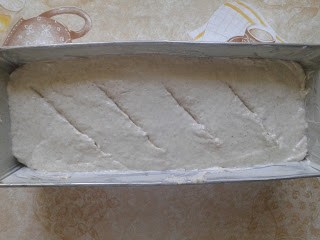
Zakwas - what is that?
For those of you, who know a bit of polish, kwas = acid. But "za kwas /kwaśne " -> too sour?Yes, there is a bit of truth.
Zakwas, meaning sourdough or natural leaven is a bread product made by long fermentation (ca. 5 days) of dough using naturally occuring in rye flour bacteria and wild yeast.
It is used to bake bread, mainly rye-based. The bread with sourdough is a bit more dense and sour - thanks to lactic acid produced by bacteria ;-)
 |
| Sourdough (starter) |
The preparation is very simple. You need only rye flour, water and patience :-P... as it has to be fed every day for 5 days.
 |
| Sourdough bread left to rise (needs 5-8 hours) |
 |
| Freshly baked sourdough bread |
- easy to digest
- improves glucose tolerance
- long fermentation breaks down gluten - some gluten-sensitive people can tolerate it
- contains minerals such as iron, zinc, magnesium, phosphorus etc.
- stays fresh for longer time than typical white bread!
 |
| Sourdough bread ready to be eaten :) |
Once you've made the sourdough, or easier you've get it from a friend, you can keep it in the fridge for a long time . The more mature natural leaven, the better bread. But remember to feed it once a week or before making a bread!
It's a bit like Tamagotchi ;-)
Natural leaven in polish cuisine is also used to prepare Żurek - a sour rye soup, traditionally eaten at Easter. More about it in our post about traditional Easter in Poland.
Have you tried this type of bread being in Poland?





.JPG)




















